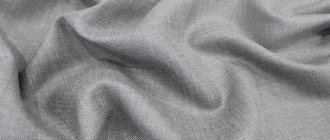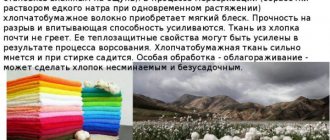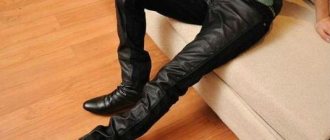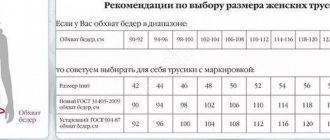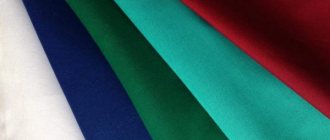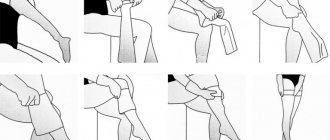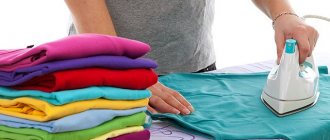Drying linen items
The sun's rays are a natural bleach for linen fabrics, so it is better to dry colored items in the shade. The hot sun will make the fabric stiff and difficult to iron. And since the tubular structure of the fibers absorbs foreign odors, the best place is fresh air or a well-ventilated room. To avoid the appearance of unnecessary folds, hang the clothes wet, slightly smoothed with your hands. A hanger will help maintain its shape, as the water will flow down and slightly stretch the product.
If possible, dry clothes horizontally, straightening them out. Linen dries instantly, so it doesn’t take much time. To speed up the process, clothes can be wrapped “snail-like” in a terry towel and left for 5 minutes. After this, just shake the item and send it to the ironing table.
Ironing linen products
Linen eco-friendly clothing does not need to be ironed. However, some still prefer to do this, because creases on things should be in those places where the human body makes them, and not clotheslines or a drying machine.
When ironing, you must use steam mode. By properly washing and drying linen items, almost all creases in clothing will disappear, but the good fabrics made from natural linen fibers will still wrinkle slightly. However, over time, the products will become softer, and you will definitely notice that they become much less wrinkled.
Linen items should be ironed when slightly damp. If the product has embroidery, it is recommended to iron from the inside out so as not to spoil the decorative element.
Proper ironing of linen items
The main feature of linen is its textured folds, which, unlike other natural fabrics, look elegant and appropriate. Such items should be ironed carefully, avoiding creases and sudden movements. The iron is set at 200 °C with the steam boost function, and the laundry itself is moistened or ironed under-dried (not wet). The evaporating moisture will protect the delicate fabric from overheating.
To restore linen's natural shine, clothes should be ironed on the right side. And if the item shrinks a little after washing, iron it through a layer of thick fabric. Do not try to remove natural folds, they will still form, but they will look natural. Linen is allowed to be wrinkled - this is its special charm.
Washing linen products
Many people do not know what is the best method to wash linen products: in a washing machine or by hand? In fact, linen is machine washable because it can withstand very high temperatures. Almost up to 90 degrees. Just before washing, you must separate it from other items, especially colored ones, since if another item “bleeds dye,” then this color will remain on the linen forever.
If the product is not made from pure linen, but contains additives from other fabrics, then it is better to choose a delicate mode up to 40 degrees. Also, to preserve the color and brightness of the fabric, you can add a spoonful of salt to the product before washing. After washing, the product must be rinsed; this can be done using a washing machine or manually, while you can add just a little vinegar to the water, which will also have a good effect on the appearance of the fabric.
Rinsing items is very important, since linen fibers absorb water very well, and with it detergent, which can then destroy the fibers of the fabric if it remains in it. After all these manipulations, you can use the machine spin in the washing machine. But if the washing was done by hand, then it is better not to wring out the fabric, as there may be creases on it that will be very difficult to remove with an iron.
How to store linen clothes?
Before storing linen items in the closet for storage until next season, be sure to iron them. It is recommended to place the laundry in vacuum packaging or wrap it in craft paper. Linen items should not be pressed or hung tightly together. Bulky clothes (jackets, trousers, suits) can be thrown directly onto the bar on hangers.
Be sure to take care of the absence of excessive heat and direct sunlight. Clothes should be taken out and aired from time to time, otherwise they will smell unpleasant. With proper care, with the onset of the summer season, linen items just need to be sprayed with water and ironed to remove any creases that have appeared. If your clothes are dry, put them in a bag and leave them in the freezer for a day. After this, ironing out old folds will become much easier. Interestingly, linen items only become easier to care for over time. The more often you wear your favorite linen shirt, the more often you wash it. And with proper care, the fibers of the fabric do not fade, they only become softer and more pleasant to the touch. Therefore, such practically “immortal” clothes are more expensive than cotton and other natural materials.
What to do if stains appear on linen clothes?
The problem can be solved both in dry cleaning and at home.
- Treat sweat stains with a mixture of wine alcohol and citric acid. For one hundred grams of wine alcohol we take ten grams of citric acid. Soak the stain in the solution for several minutes and rinse very thoroughly with warm water.
- Another folk remedy for removing sweat stains: dissolve a teaspoon of salt in two hundred grams of water and add the same amount of ammonia. We treat stains and rinse the product several times.
- Ammonia is indispensable for removing grease stains. Add one teaspoon of ammonia to a glass of water and wipe the stain. Rinse with warm water. You can also get rid of fresh blood stains using the same method. Please remember that blood stains should not be washed off with hot water.
- Wash stains from berries, fruits, and wine immediately with warm water. If this is not possible, when you come home, wash the stain in hot milk. Stains on light-colored fabric can be treated with hydrogen peroxide.
- Do not use bleach or chlorine-containing substances to remove stains on linen; they make the flax fibers thin and the fabric turns yellow.
Chart of clothing care symbols
Please pay attention to the textile care label on the garment.
He will tell you what your clothes are made of, how to wash, dry and iron them. When removing specific stains, be sure to follow the instructions to avoid unpleasant surprises. The care symbols are international and language independent. Below are the most important textile care symbols. The product may be subject to boiling. White from cotton and linen or colored boil-resistant.
The product can be machine washed at a temperature of no more than 95° C. Maintain the water temperature, do not subject it to strong mechanical treatment, and when spinning, use a slow centrifuge mode.
The product can be machine washed at a temperature of no more than 60° C. Colored laundry is not resistant to boiling. Delicate linen made of cotton or polyester fabrics.
Washing colored linen at a temperature of no more than 60° C. Maintain the water temperature, do not subject it to strong mechanical treatment; when spinning, use a slow centrifuge mode.
Wash with neutral detergents at a temperature of no more than 40° C. Dark and colorful cotton linen, polyester or melange fabrics, fine linen made of viscose and synthetic fibers.
Wash with neutral detergents at a temperature of no more than 40° C. Maintain the water temperature, do not subject it to strong mechanical treatment; when spinning, use a slow centrifuge mode.
The product can be machine washed at a temperature of no more than 30° C. Washing with neutral detergents. Woolen items are machine washable.
Washing should be done only by hand at a temperature of no more than 30°C degrees, in a short period of time. The product should only be washed or squeezed lightly by hand without twisting.
The product should not be washed. Dry cleaning should be used.
The iron temperature should be no more than 200 °C. Cotton, linen, textiles in wet condition.
The iron temperature should be no more than 150 °C. Cotton, silk, polyester, viscose. Iron with a slightly damp cloth or iron with a steam humidifier.
The iron temperature should be no more than 110 °C. Polyacrylic, polyamide, polyester, acetate.
The product should not be steamed.
The product should not be ironed.
The product cannot be pressed or tumble dried.
The product can be dried in a drum dryer.
The product can be tumble dried at low temperatures.
The product can be tumble dried at medium temperature
The product cannot be pressed or dried.
The product should dry in the shade.
Products saturated with moisture should be hung to dry.
Products saturated with moisture should only be laid out on a horizontal surface for drying.
The product can be dried vertically while hanging.
The product can be dried.
The product must not be dry cleaned.
When dry cleaning, some care is required depending on the solvent used, mechanical stress and drying temperature.
Dry cleaning of the product can be done using perchlorethylene, gasoline, trifluorotrichloroethylene, or monofluorotrichloromethane using conventional cleaning processes.
Dry cleaning of the product can be done using perchlorethylene, gasoline, trifluorotrichloroethylene, or monofluorotrichloromethane using conventional cleaning processes.
When dry cleaning, special care is required depending on the solvent used, mechanical stress and drying temperature.
The product may only be dry cleaned with gasoline or trifluorotrichloroethane using normal cleaning processes.
Dry cleaning using organic solvents.
The product cannot be bleached
The product can be bleached.
The product may be subject to boiling. White from cotton and linen or colored boil-resistant.
The product can be machine washed at a temperature of no more than 95° C. Maintain the water temperature, do not subject it to strong mechanical processing, when spinning, use a slow centrifuge mode.
The product can be machine washed at a temperature of no more than 60° C. Colored laundry is not resistant to boiling. Delicate linen made of cotton or polyester fabrics.
Washing colored linen at a temperature of no more than 60° C. Maintain the water temperature, do not subject it to strong mechanical treatment; when spinning, use a slow centrifuge mode.
Wash with neutral detergents at a temperature of no more than 40° C. Dark and colorful cotton linen, polyester or melange fabrics, fine linen made of viscose and synthetic fibers.
Wash with neutral detergents at a temperature of no more than 40° C. Maintain the water temperature, do not subject it to strong mechanical treatment; when spinning, use a slow centrifuge mode.
The product can be machine washed at a temperature of no more than 30° C. Washing with neutral detergents. Woolen items are machine washable.
Washing should be done only by hand at a temperature of no more than 30°C degrees, in a short period of time. The product should only be washed or squeezed lightly by hand without twisting.
The product should not be washed. Dry cleaning should be used.
The iron temperature should be no more than 200 °C. Cotton, linen, textiles in wet condition.
The iron temperature should be no more than 150 °C. Cotton, silk, polyester, viscose. Iron with a slightly damp cloth or iron with a steam humidifier.
The iron temperature should be no more than 110 °C. Polyacrylic, polyamide, polyester, acetate.
The product should not be steamed.
The product should not be ironed.
The product cannot be pressed or tumble dried.
The product can be dried in a drum dryer.
The product can be tumble dried at low temperatures.
The product can be tumble dried at medium temperature
The product cannot be pressed or dried.
The product should dry in the shade.
Products saturated with moisture should be hung to dry.
Products saturated with moisture should only be laid out on a horizontal surface for drying.
The product can be dried vertically while hanging.
The product can be dried.
The product must not be dry cleaned.
When dry cleaning, some care is required depending on the solvent used, mechanical stress and drying temperature.
Dry cleaning of the product can be done using perchlorethylene, gasoline, trifluorotrichloroethylene, or monofluorotrichloromethane using conventional cleaning processes.
Dry cleaning of the product can be done using perchlorethylene, gasoline, trifluorotrichloroethylene, or monofluorotrichloromethane using conventional cleaning processes.
When dry cleaning, special care is required depending on the solvent used, mechanical stress and drying temperature.
The product may only be dry cleaned with gasoline or trifluorotrichloroethane using normal cleaning processes.
Dry cleaning using organic solvents.
The product cannot be bleached
The product must not be bleached with chlorine-releasing agents.
The product may be bleached with chlorine-releasing agents.
The product can be bleached.
Color care and label information
Some clothing is sensitive to oxygen bleaches/perborate, which is added to products to better remove stains from white and colored clothing. To keep your items from fading in the wash, read the label carefully, and if you're not sure whether your clothes are sensitive to color-safe bleaches (usually labeled with a "Do Not Bleach" symbol), do a quick test before washing them. , how to start washing as usual.
• Wet a small area of the hem or inside seam of the garment. • iron a piece of white cloth or napkin onto it. • If color marks appear on the paper, your clothing is susceptible to fading and should be washed separately.
How to wash linen?
Not every powder is suitable for washing this fabric. Use a product with ingredients that increase the alkalinity of the water. They will help speed up the process of removing dirt and have a positive effect on the fabric. Do not wash the material with chlorine powder, as chlorine-containing products reduce the strength of the fibers.
Laundry powder without chlorine (photo source: Yandex.Pictures)
For white items, it is allowed to use oxygen bleach; for undyed items, powders without chlorine and sulfates must be used. If there is no special product, replace it with laundry soap, stain remover, gel for delicate fabrics or children's clothing.
How to wash by hand correctly?
Washing jackets, pants, curtains, skirts and dresses by hand takes a lot of effort, but if the item is dear to you - for example, a handmade dress, it is better to spend more effort and time than to risk sending it to the washing machine. Take a larger basin and dissolve a little detergent in water. Wash items thoroughly and rinse them by hand. When washing colored items, regardless of their size, it is advisable to add a teaspoon of acetic or citric acid to the rinse water.
